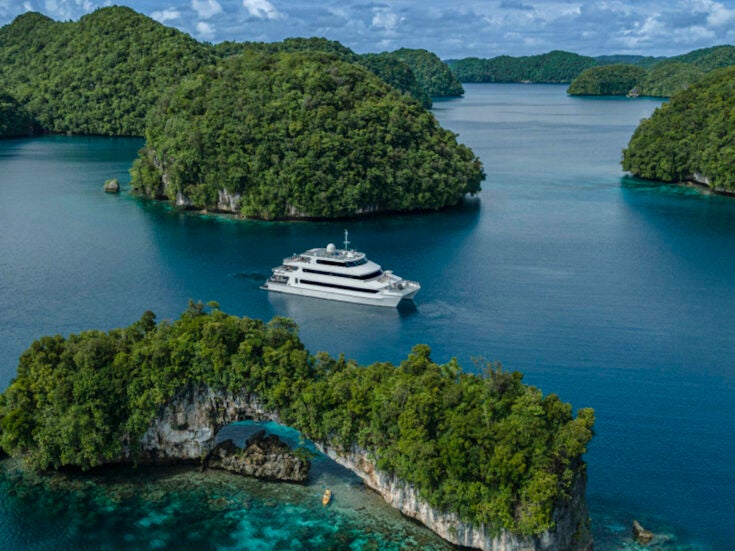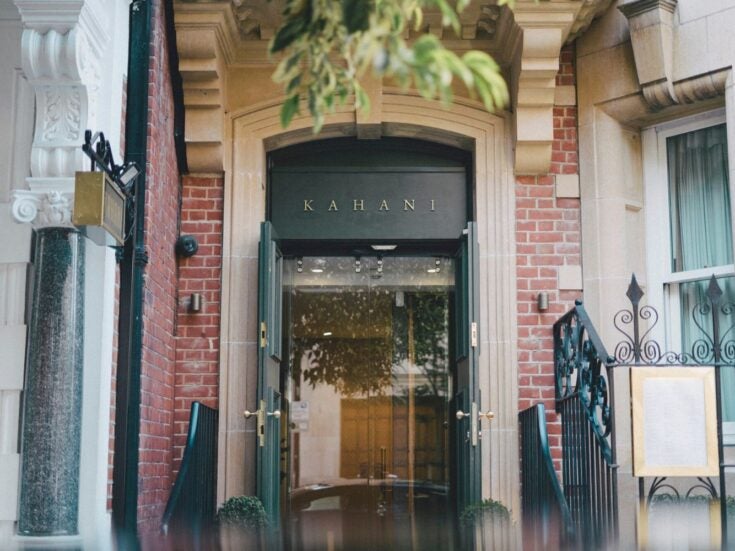
The Berth of Civilisation
Josh Spero feels on top of The World between adventures in Colombia and Aruba as he samples the many delights of a luxury vessel which allows you to call any port on the Seven Seas home
‘I SAID, “WE’LL treat it like our mistress.”’ Some mistress: weighing 44,000 tonnes and reaching up twelve storeys, The World would intimidate even the most amorous philanderer. More unusual was that the speaker was talking not about keeping a secret from her husband, but about her and her husband not telling their friends.
They didn’t understand, she said, as our fourth course arrived; they thought The World was a cruise ship, the sort with midnight buffets piled high and a squirm-inducing cabaret, so she said no more about it and instead enjoyed the frisson of having a secret. A secret seen in over 800 ports around the world.
The World is defiantly not a cruise ship: it is — though no one on board put it in quite these terms — a prosperous free-thinking community which lives in luxury as it churns through seas and oceans, a utopia on the briny, like Plato’s Republic but with property rights and polar expeditions.
Rather than a floating hotel, which is what cruise ships are, once you’ve bought a residence on The World, like any other piece of property it’s yours forever and you can visit it as much or as little as you like. (Of course, unlike other properties, it’s never where you last left it.) When residents talk about their suite on The World, they more often than not refer to it as home, and not just ‘my home’ but ‘our home’, encompassing their fellow residents.
A libertarian streak is strong among the successful entrepreneurs and their partners, average age 58 but falling, who have made The World their berth, whether full-time (six are always on board) or for stretches of weeks or months at a go.
Perhaps live-and-let-live is the only way to exist when you spend so much time with the same people, but the macro- and micro-communities which have formed aboard The World indicate that there is more to it than contingency or mutual self-interest. The golfers like to get together to swing and putt on several hundred virtual courses in the golf studio. The poker-players and bridge-heads tend to shuffle, cut and deal on sea days, when no excursions are possible. Some of the Jewish couples have a Friday-night kiddush service together.

If you don’t want to go to the fashion show the crew put on with clothes from the boutique — slightly suggestive of what probably happened on a quiet Wednesday afternoon at Versailles under Louis XIV — or the films screened or the regular lectures on everything from art to bioethics, there’s none of the enforced jollity or group compulsion which infuriates.
THERE IS CERTAINLY no crush from weight of numbers. A ship of The World’s size would normally take 1,500 passengers but at most times it in fact has between 100 and 150 people, rising to 300 over Christmas, in its 165 residences, which means it feels spacious, peaceful, quiet.
You can wander through deck five, with its well-provided deli-café, or dawdle in deck six’s library (stocked with magazines — including Spear’s, of course — and the complete Everyman’s Library), or even recline by the pool on deck eleven with some chic twist on a tropical fruit cocktail and not ever feel overwhelmed by a herd of fellow residents.
Necessarily less libertarian than its multiple communities, but more democratic, is that the residents get to vote on the ship’s overall itinerary. This is both crucial and trivial, in a way. The captain, a broad-faced Norwegian called Dag Sævik, told me that when they counted how many different ports The World had docked or anchored at in its first decade, they found it was 840, so even if your itinerary doesn’t win, there are bound to be enough delights on the journey to make up for it.
It’s worth charting recent and future courses to demonstrate. Last year, The World saw in January in Cape Town before a couple of stops in Namibia, then several days at sea to reach Mauritius and a longer haul across the Indian Ocean to seven stops in Australia and eleven in New Zealand.

Then, across the Pacific via Melanesia, Polynesia and Hawaii, up the west coast of America and Canada, before becoming the largest passenger ship ever to ford the Northwest Passage. (On your apartment’s on-demand TV service, incidentally, you can watch a full-length documentary about this voyage, which with its ice floes and polar plunges seemed as astounding as you might imagine.) America’s east coast and the long chain of Caribbean islands must have come as quite an anti-climax after that.
The decorated streets of Cartagena
I PICKED UP The World in Cartagena, Colombia, in January at the tail end of its Caribbean sojourn, riding it to Aruba, before it was due to cross the Atlantic to the Cape Verde Islands, head up to Britain, sail along Norway’s coast by June and then do a long turn around the Mediterranean (I counted 44 stops). Next year will in the main be devoted to a long exploration of the Pacific, Australasia, South-East Asia, China and Japan. Nor are these flying visits: several days in port are assigned to many destinations. It’s not like the residents of The World are in any rush to get home.
There were only a few hours between a tour of The World and the ship leaving for Oranjestad, Aruba, to see Cartagena, so no real time for the Castillo San Felipe de Barajas, a Spanish colonial fort, or the museum in the house of Rafael Nuñez, local boy and early president of independent Colombia, but there was the pick of street food.
It turns out that residents of Cartagena like things salty: a mango, helpfully macheted into wobbling chunks, was covered in salt then doused in lime juice, while a fried cheese sandwich (actually a cheese sandwich, with thick solid white cheese instead of bread) was filled with parmesan’s saltier cousin.
If there doesn’t seem to be much to do in Cartagena, there’s certainly a lot to see. Its colonial defensive walls encircle the Old Town and a walk along them offers views of the sea, as well as a view over high orange walls on to the rear of Gabriel Garcia Marquez’s house, who set Love in the Time of Cholera in a facsimile of Cartagena. In abundance are the smart boldly painted houses, the grandest examples of which have wooden balconies, their beams and balusters in the grip of clematis or other trailing flowers.

This was all a bit elegant, so I have to confess that when I encountered the silk-flower market, two rows of cabins stacked from floor to ceiling with fake flora in violent yellows and oranges, purples and pinks, cloth sprays of unreal roses and lilies and daisies, and no refreshing hint of natural green near, I went a bit Jeff Koons and kitsched out. It was exactly the break from decorousness needed.
Flowers fit for Jeff Koons at Cartagena’s silk flower market
BACK ON THE ship, decorousness is in the eye of the decorator. One of the privileges of home — complete and utter redecoration — is afforded to residents, once they have passed their plans by The World’s powers that be. In a 2,500sq ft four-bedroom residence on deck ten (which was sold shortly after I debarked), walls were about to be torn down, doors shifted, closets ripped out and an extra bedroom put in.
As long as the fabric of the ship is not disturbed, said residential director Roz Colthart as we toured a number of empty residences, it should be fine. Once you’ve arranged your rooms, you can install whatever you like, and residents put up art from their collection, including one delightful Chagall, a study for his ceiling at the Paris Opera, which I saw over a glass of champagne with a resident couple before dinner at East, the pan-Asian restaurant.
Of the four restaurants on The World, East was memorable, but Portraits (another unfortunately generic name) was Michelin-good. I was dining with a British businessman, his glamorous wife and her sister, who had come aboard for a week, in this sleek, dark salon.
The food was modern haute cuisine: aerated almond brioche with the pork belly starter; vanilla cream on the butter-poached lobster reflecting a sweet-savoury trend; a simple name — ‘Coffee and Chocolate’ — hiding that pair four ways, including a light, warm doughnut on a scoop of coffee ice cream. The paired wines were more than suitable, although the stand-out was a Spanish fortified wine that the knowledgeable yet modest sommelier, Marinela, had picked up on one of The World’s stops.

Wine is an area in which The World’s residents find the ship particularly accommodating. There are 14,500 bottles on board, including several private collections, which their owners can call up for meals or indeed at any time. I think my only complaint, beverage-wise, is the crew’s rather American approach to making tea: hot water poured into cup, bag inserted into cup. An end was quickly put to that.
A flash of colour in Aruba
THERE WAS A task waiting for me in Aruba, which we reached after a sea day skirting Colombia’s north coast. The grandparents of a friend of mine came as Anglican missionaries to Aruba in the Forties and he said they had built a church in San Nicolas, two or three miles by his reckoning from Oranjestad, the ghastly semi-Disneyfied capital with its designer shops crammed into ugly arcades beside pavements overcrowded with pallid, moribund Americans. His family had no photos of the church, and since I was in Aruba I volunteered to find it and shoot it.
Once we had docked, The World provided a bike, cycling helmet and two vital bottles of icy Fiji Water, and I set off from the quayside, whizzing past tourists from other ships slumping their way on to Oranjestad’s main drag. While a cluster of cyclists in front turned left for the recommended tourist trail, San Nicolas was right, past a perpetual traffic jam, over a scenic bridge and alongside shining beaches.
The coastal road is a single carriageway for most of its length, which meant tankers and trucks overtook the bicycle with ineloquent honks, as if the panicky rider sticking as close to the outside edge might be unconscious of the monsters rearing up behind him.
On the quieter sections of the road, you could glance to the left and see the Arikok National Park, which covers a fifth of the island. The park offers fertile tourist material, with a cave system, hiking trails, gold mines and Arawak paintings, and its green and hilly landscape rose all the more appealingly from the burning, flat, endless road.

On through the small town of Savaneta I rode, noting the plentiful Chinese restaurants and groceries, once stopping to ask some old men how far San Nicolas was. Another twenty minutes by bike, they said; I had already been going, gently uphill mostly, for well over an hour. This was not three miles.
ELEVEN TARMACKED, SWEATY miles from Oranjestad, the outskirts of San Nicolas with their low, dirty-cream-coloured houses crept up near the eastern tip of the island. Enquiries of locals about the location of the Holy Cross Church were fruitless and every church I passed raised my hopes. St Theresa? No. Baptist? No. Seventh-day Adventist? Still no.
Eventually I gave in and turned on my data roaming to ask Google Maps, which told me to turn around and take a right on to Weg Seroe Preto (Black Mountain Street, the man in whose truck I hitched a lift back to Oranjestad later told me). After stopping to take a photo of the sign on Flamboyant Street, I found the church.
A small plaque low in the magnolia rear wall of the church confirmed that this was the right one: ‘AMDG [to the greater glory of God]/Blessed by Bp Davis of Antigua/Laid by Dr LC Kwartsz Lt Gov of Aruba/31st August 1947.’ There was no one around, and no obvious vicarage, so the locked front door had to stay locked, but I could peep in through the open window slats on to what looked like a fairly simple Anglican church.
Beside the church’s porch were well-tended flowerbeds, and by the low wall which ran along Tulpenstraat (Tulip Street) some giant flaming red flowers — not tulips — reached up, joyful and lonely.
When I got back to The World — after some interesting conversation with the gentleman with the truck, who turned out to be in an Aruban musical group — I still had a day in port before my flight, but there was no desire to see more of Aruba. Instead, there was a massage in the ship’s spa and dinner with some charming residents, and then work on my final morning. Soon after I left for the airport, The World left, too, carrying its community with it.
Don’t miss out on the best of Spear’s articles – sign up to the Spear’s weekly newsletter
[related_companies]





